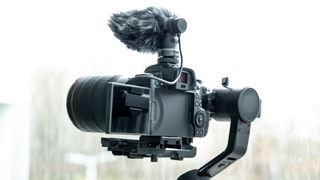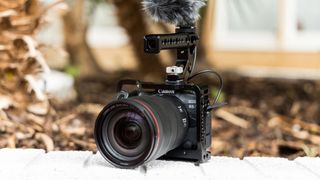New Canon EOS R5 video specs confirm it’ll be a game-changer – here’s why
8K mirrorless camera has surprisingly few compromises

The Canon EOS R5 has given video directors and YouTubers a welcome boost by teasing a few more of its official specs – and the new announcements confirm that the R5 will break new ground for mirrorless cameras.
Last month, Canon batted away suggestions that the EOS R5's video powers would be compromised in a similar way to previous models like the EOS R, by confirming that it will shoot 8K video internally at 30fps using the full width of its sensor.
And now Canon has followed that up with some even bigger video spec announcements. One of the most interesting is that the EOS R5 will be able to shoot 4K video at up to 120fps, making it a potentially great option for shooting high-quality slo-mo footage. That mode has only previously been available on professional Cinema EOS cameras like the C200.
Even better, Canon has confirmed that when shooting video on the EOS R5 "Dual Pixel AF is available in all video modes at all resolutions and frame rates". That's pretty incredible, given the Canon 1DX Mark III can't even manage that – that pro DSLR doesn't offer Dual Pixel AF when shooting in either Raw or 60p modes.
- Read our Canon EOS R5 release date, news and features round-up
- Or check out our in-depth Why buy a Canon EOS R5? interview with Canon
- These are the best cameras you can buy right now
What else is new?
Another bit of interesting news is the confirmation of the Canon EOS R5 video codecs. When shooting uncropped 8K and 4K, it'll shoot 4:2:2 10-bit in Canon Log (H.265) or 4:2:2 10-bit HDR PQ (H.265). As we knew from a previous announcement, you'll also be able to shoot 8K Raw video internally at up to 29.97fps.
There's no official news on 8-bit options for smaller file sizes, but the confirmed 10-bit recording and those codecs is welcome news for pros who fancy using the EOS R5 as a second camera alongside their main Cinema workhorse. Shooting in 10-bit 4:2:2, an option that first arrived on mirrorless cameras with the Panasonic GH5, provides more color data and depth for colorists to work with in post-production, compared to alternatives like 8-bit 4:2:0.
Canon says this means the EOS R5 will be "an ideal support filming camera" that will "shoot comfortably on high-end production sets", and from the specs released so far it's hard to disagree. That said, there are still many details we don't know about, including recording limits and how exactly the EOS R5 will avoid heating issues, given it has a much smaller body than Cinema EOS cameras.
Get daily insight, inspiration and deals in your inbox
Get the hottest deals available in your inbox plus news, reviews, opinion, analysis and more from the TechRadar team.

One final bit of news from concerns the EOS R5's dual cards slots – Canon has confirmed that one of these will be a CFexpress slot, with the other being SD UHS-II. Unlike the 1DX Mark III, which has dual CFexpress slots, this shows the EOS R5 has one eye on attracting semi-pros and well-heeled amateurs too.
CFexpress cards offer incredible data transfer rates that are ideal for shooting 8K video and rapid-fire stills, but are significantly pricier than the more common SD alternatives. Presumably Canon feels this will help the broaden the EOS R5's appeal beyond the professional world.
Why the Canon EOS R5 is a big deal
So what do these announcements all mean for the Canon EOS R5 and cameras in general? The EOS R5 certainly won't be the first small, mirrorless camera to be used by professional directors and filmmakers – the Panasonic GH5 has been a favorite of aspiring Werner Herzogs for a while now, and brought features like internal 10-bit 4:2:2 recording to wider audience back in 2017.
But from the specs so far, the EOS R5 is going to raise that video bar for mirrorless cameras again. For a start it's a full-frame camera, so has a far bigger sensor than the Micro Four Thirds GH5. Despite that large sensor, it promises features like uncropped 8K, the ability to shoot 4K at 120fps and, perhaps best of all, Dual Pixel autofocus in every video mode. All of this from a body that's similar in size to the Canon EOS R and has five-axis IBIS (in-body image stabilization).

On paper, it's hugely impressive stuff and promises to fix all of the strange video limitations we've seen on recent Canon cameras like the EOS R. Features that have previously been reserved for Cinema EOS cameras are getting shoehorned into a run-and-gun, mirrorless body. And while the EOS R5 isn't going to be cheap – rumors suggest it will cost in the region of $3,500 / £3,500 / AU$4,500 – it does promise more powerful features than any other camera in its weight category. Unless the Sony A7S III arrives soon to steal its thunder.
Naturally, this all comes with the caveat that there are still many unknowns about the EOS R5. For example, we don't yet know anything about video recording limits, or how it will handle heat. And until we've been able to take one for a spin, we also won't know how well it handles potential issues like rolling shutter, which was a problem on the Canon EOS RP.
But from the confirmed specs so far, the Canon EOS R5 is undoubtedly the most exciting camera of the year, whether you're a stills shooter or filmmaker. We'll bring you more official news as get it.
- Read our in-depth Canon EOS R5: everything we know so far feature

Mark is TechRadar's Senior news editor. Having worked in tech journalism for a ludicrous 17 years, Mark is now attempting to break the world record for the number of camera bags hoarded by one person. He was previously Cameras Editor at both TechRadar and Trusted Reviews, Acting editor on Stuff.tv, as well as Features editor and Reviews editor on Stuff magazine. As a freelancer, he's contributed to titles including The Sunday Times, FourFourTwo and Arena. And in a former life, he also won The Daily Telegraph's Young Sportswriter of the Year. But that was before he discovered the strange joys of getting up at 4am for a photo shoot in London's Square Mile.
